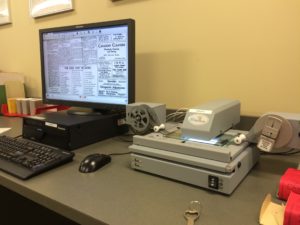Despite my status as a “postgraduate researcher,” I had never experienced microfilm until this afternoon. For those who don’t know, microfilm is a form of document preservation similar to photo negatives. The U.S. National Archives and Records Administration argues that microfilm is “a low-cost, reliable, long-term, standardized image storage medium” that only needs simple machinery to view and has a life expectancy of hundreds of years, if cared for. “Digital images,” they claim, “consist of a wide variety of machine codes that require computer hardware and software to be made visible. To avoid the obsolescence of changing computer technology, digital images must be reformatted periodically.”
However, I prefer Urban Dictionary’s definition: “The flash drive of the 1970’s.”
My experience with this medium began at 1:00 pm, when I walked up to the front desk of the University of Richmond’s library and asked for two reels that had been sent through Interlibrary Loan, or ILL. I was handed two dilapidated cardboard boxes, each containing hundreds of images of early-1900’s Socialist newspaper articles from The Workers’ World captured on two long strips. I then went down to the second basement level to try and find the machine I assumed was needed: a goofy-looking industrial printer with a tube TV screen thingy mounted on the top.
To my dismay, that machine was out of order. As I kept searching, though, I found what looked to be a heavy-duty paper cutter or a fat microscope connected to one of the library’s computers. The label said “ST ViewScan.” I’m not the kind of person who enjoys asking for assistance (a fact I’m not particularly proud of), but I also knew that I needed to be careful with the two reels. After spending no less than ten minutes trying to figure out how to run the film under the rollers and beneath a pane of glass resting on a light source, I booted up the ViewScan software and watched as an image of The Workers’ World appeared on my screen.

The controls were a bit finicky, but once I got the hang of both physically rolling the film and digitally altering the zoom, focus and brightness levels every once and a while, I began to get into a rhythm. It’s funny how foreign such an important device felt to me, especially considering how much research I’d conducted while I was an undergrad. In this day and age, there are a plethora of tips and tricks that help folks find information faster. Ever heard of ctrl+f ? If a professor were to ask you to talk about particular uses of “lips” in Bram Stoker’s Dracula, one has to only find an online version and search for that keyword. I can’t tell you how many times I wished I could simply type in the name of the individual I was looking for in the microfilm; instead, I just had to keep scrolling and scrolling and scrolling as I visually scanned each and every word in the papers.
Nevertheless, there’s a sort of reverence—for lack of a better word—associated with working with tangible mediums. Looking up The Doobie Brothers in YouTube and hitting Play isn’t the same as going to a record or music store and picking up an album in person. The same logic applies to the microfilm I was handling. Sure, it would have been easier to just go online and try to find a digital copy that’d been scanned by some random person in a library. But this…this was real. In 100 years, what will last longer: the newspaper article you saved onto your hard drive, or a reel of microfilm that can have a viewer built at any point in time?
I hope this reverence isn’t lost on the younger generations. Things have become a bit too automated, too instant-gratification oriented. Will traditional libraries even be around in the next 15-20 years? It’s only a matter of time before the musty smell of old books and worn paper (or in my case, the delicate and finicky film strips) become a thing of the past. Preservation is one thing, but reliance is an entirely different can of worms.
TL:DR Let’s get physical.


